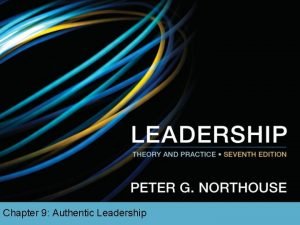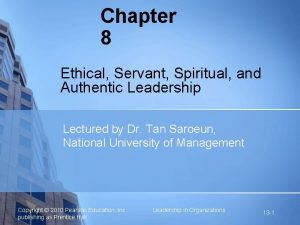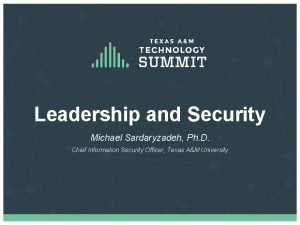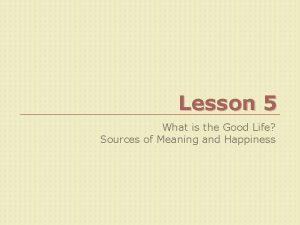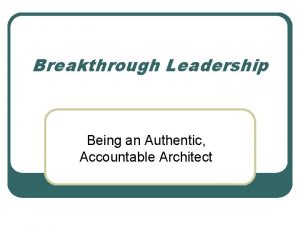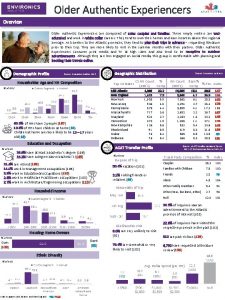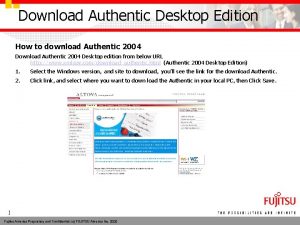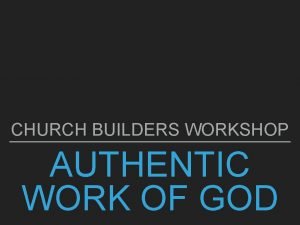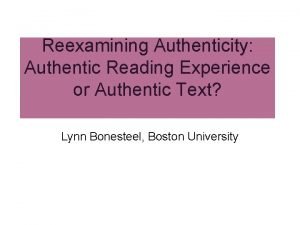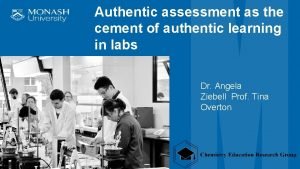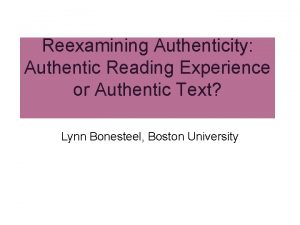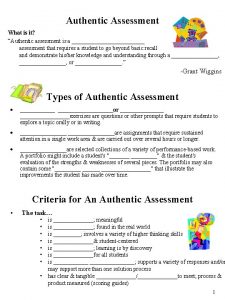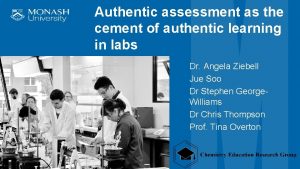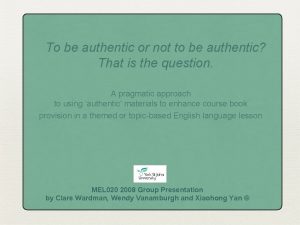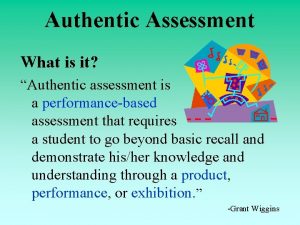Chapter 9 Authentic Leadership Overview Authentic Leadership Description


















- Slides: 18

Chapter 9: Authentic Leadership

Overview ÷ Authentic Leadership Description ÷ Authentic Leadership Defined ÷ Approaches to Authentic Leadership ÷ Practical ÷ Theoretical ÷ How does Authentic Leadership Theory Work? Peter G. Northouse, Leadership: Theory and Practice, Seventh Edition. © 2016 SAGE Publications, Inc.

Authentic Leadership Description ÷ Authentic Leadership – focuses on whether leadership is genuine ÷ Interest in Authentic Leadership ® Increasing in recent times due to social upheavals ® People longing for trustworthy leaders ® Identified earlier in transformational leadership research but not studied separately ® Needed evidence-based research of construct Peter G. Northouse, Leadership: Theory and Practice, Seventh Edition. © 2016 SAGE Publications, Inc.

Authentic Leadership Defined ÷ Intrapersonal Definition: ® Leadership based on self-concept and how self-concept relates to actions (Shamir & Eilam, 2005) ® Relies on the life story of the leader ÷ Three Authentic Leadership Characteristics: ® ALs exhibit genuine leadership ® ALs lead from conviction ® ALs are originals, not copies Peter G. Northouse, Leadership: Theory and Practice, Seventh Edition. © 2016 SAGE Publications, Inc.

Authentic Leadership Defined ÷ Interpersonal Definition: ® Leadership is created by leaders and followers together (Eagly, 2005) ® It is a reciprocal process because leaders affect followers and followers affect leaders Peter G. Northouse, Leadership: Theory and Practice, Seventh Edition. © 2016 SAGE Publications, Inc.

Authentic Leadership Defined ÷ Developmental Definition: ® Leadership can be nurtured and developed over a lifetime (Avolio & Gardner, 2005) ® Can be triggered by major life events ® Leader behavior is grounded in positive psychological qualities and strong ethics ÷ Four authentic leadership components: ® Self-awareness ® Internalized moral perspective ® Balanced processing ® Relational transparency Peter G. Northouse, Leadership: Theory and Practice, Seventh Edition. © 2016 SAGE Publications, Inc.

Practical Approaches to Authentic Leadership ÷ Bill George (2003, 2007) ® Leader characteristic model ® Leaders have genuine desire to serve others ® Five characteristics of authentic leaders • Understand their purpose • Strong values • Trusting relationships • Self-discipline • Act from the heart (mission) Peter G. Northouse, Leadership: Theory and Practice, Seventh Edition. © 2016 SAGE Publications, Inc.


Theoretical Approaches to Authentic Leadership Recent Research Spurred By ÷ Leadership summit publications (2005) ÷ Social upheaval and desire for leadership that serves the common good ÷ Need to explore meaning of authentic leadership and create theoretical framework ÷ Need to define the construct of authentic leadership Peter G. Northouse, Leadership: Theory and Practice, Seventh Edition. © 2016 SAGE Publications, Inc.

Definition of Authentic Leadership “A pattern that draws upon and promotes both positive psychological capacities and a positive ethical climate, to foster greater self-awareness, an internalized moral perspective, balanced processing of information, and relational transparency on the part of leaders working with followers, fostering positive self-development. ” -Walumbwa, Avolio, Gardner, Wernsing, & Peterson, 2008 Peter G. Northouse, Leadership: Theory and Practice, Seventh Edition. © 2016 SAGE Publications, Inc.

Basic Model of Authentic Leadership FOUR COMPONENTS ÷ Self-awareness ® Reflecting on one’s core values, identity, emotions, motives ® Being aware of and trusting one’s own feelings ÷ Internalized moral perspective ® Self-regulatory process using internal moral standards to guide behavior ÷ Balanced processing ® Ability to analyze information objectively and explore other people’s opinions before making a decision ÷ Relational transparency ® Being open and honest in presenting one’s true self to others Peter G. Northouse, Leadership: Theory and Practice, Seventh Edition. © 2016 SAGE Publications, Inc.

Factors That Influence Authentic Leadership ÷ Positive psychological capacities ®Confidence ®Hope ®Optimism ®Resilience ÷ Moral Reasoning Capacities ® Deciding right and wrong ® Promoting justice, greater good of the organization or community Peter G. Northouse, Leadership: Theory and Practice, Seventh Edition. © 2016 SAGE Publications, Inc.

Factors That Influence Authentic Leadership Critical Life Events - Positive or negative ÷ Act as a catalyst for change ÷ People attach insights to their life experiences ÷ When people tell life stories they gain clarity about who they are ÷ Stimulate personal growth Peter G. Northouse, Leadership: Theory and Practice, Seventh Edition. © 2016 SAGE Publications, Inc.

How Does Authentic Leadership Theory Work? ÷ Strengths ÷ Criticisms ÷ Application Peter G. Northouse, Leadership: Theory and Practice, Seventh Edition. © 2016 SAGE Publications, Inc.

How Does Authentic Leadership Theory Work? ÷ AL is a complex, developmental process ÷ The practical approaches are prescriptive: ® George (2003) – Five characteristics leaders need to be authentic ÷ Theoretical approach describes what accounts for AL: ® Four attributes ® Attributes developed over lifetime, often through critical events Peter G. Northouse, Leadership: Theory and Practice, Seventh Edition. © 2016 SAGE Publications, Inc.

Strengths ÷ Fulfills society’s expressed need for trustworthy leadership. Fills a void in an uncertain world. ÷ Provides broad guidelines for those who want to become authentic leaders. Both practical and theoretical approaches provide a map. ÷ Like transformational and servant leadership, AL has an explicit moral dimension. ÷ Unlike traits that only some people exhibit, everyone can learn to be more authentic. ÷ Can be measured using an established instrument (ALQ). Peter G. Northouse, Leadership: Theory and Practice, Seventh Edition. © 2016 SAGE Publications, Inc.

Criticisms ÷ The theory is still in the formative stages, so some concepts in the practical approaches are not fully developed or substantiated. ÷ The moral component of AL is not fully explained. It’s unclear how higher values such as justice inform authentic leadership. ÷ The rationale for including positive psychological capacities as a part of AL has not been clearly explained by researchers. ÷ The link between authentic leadership and positive organizational outcomes is unclear. It is also not clear whether AL is sufficient to achieve organizational goals. Peter G. Northouse, Leadership: Theory and Practice, Seventh Edition. © 2016 SAGE Publications, Inc.

Application ÷ People have the capacity to become authentic leaders. It is a lifelong learning process. ÷ Human resource departments may be able to foster authentic leadership behaviors in employees who move into leadership positions. ÷ Leaders are always trying to do the “right” thing, to be honest with themselves and others, and to work for the common good. ÷ Leaders are shaped by critical life events that lead to growth and greater authenticity. Peter G. Northouse, Leadership: Theory and Practice, Seventh Edition. © 2016 SAGE Publications, Inc.
 Authentic leadership focuses on
Authentic leadership focuses on Ethical servant spiritual and authentic leadership
Ethical servant spiritual and authentic leadership Authentic leadership theory and practice
Authentic leadership theory and practice Michael sardaryzadeh
Michael sardaryzadeh Bill george authentic leadership model
Bill george authentic leadership model Emt chapter 24 trauma overview
Emt chapter 24 trauma overview Emt chapter 14 medical overview
Emt chapter 14 medical overview Chapter 9 lesson 2 photosynthesis an overview
Chapter 9 lesson 2 photosynthesis an overview Chapter 12 selling overview
Chapter 12 selling overview Financial intermediaries
Financial intermediaries Chapter 1 overview of verb tenses
Chapter 1 overview of verb tenses Overview of personal finance chapter 1
Overview of personal finance chapter 1 Mesioclusion
Mesioclusion Personal finance chapter 1 review answers
Personal finance chapter 1 review answers General features of animals
General features of animals Chapter 1 an overview of financial management
Chapter 1 an overview of financial management Elements and their properties section 1 metals
Elements and their properties section 1 metals Chapter 1 overview of financial statement analysis
Chapter 1 overview of financial statement analysis Golden rule
Golden rule
